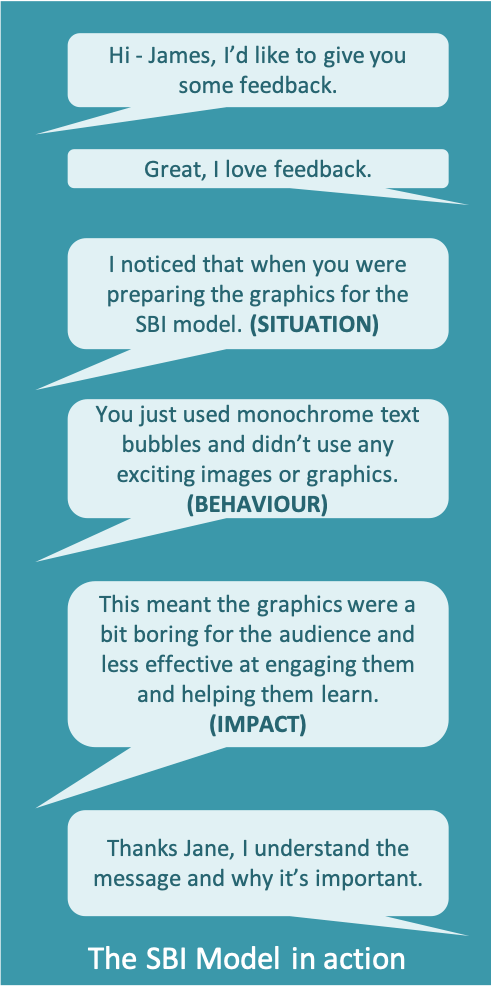The SBI feedback model is a structured approach to providing feedback. It says feedback providers should frame feedback around three things, a specific Situation, the Behaviors that took place and their Impacts.
Please note, SBI and Situation-Behavior-Impact are trademarks of the Center for Creative Leadership.
Summary by The World of Work Project
The Situation, Behavior and Impact Model
The SBI feedback model suggests that feedback messages are structured into three parts: Situation, Behavior and Impact. The SBI model works equally well for positive and negative messages, and is used for delivering one message at a time.
To use the model, the conversation should be opened and the person you’re speaking to told that you’re going to give them some feedback. Once you’ve done this, you should deliver your message using this three stage approach.
Situation

The first stage of the model is to lay out the situation in which the behavior that you’re providing feedback on took place.
The purpose of this stage is to help the recipient focus on the event, and to help them visualize it. You should be as clear and accurate as possible, but only focus on facts, not emotive words or hearsay.
Behavior
The next stage of the model is to describe the specific behaviors or actions that you’re looking to provide feedback on.
These should be described in accurate, factual terms. Do not use shortcuts or ambiguous language as doing so may lead to confusion or miscommunication.
Impact
The last stage of the model is clearly explain the impact of the behavior that you just described. If you’re providing positive feedback, be clear to demonstrate how the individual’s behavior created a positive impact. If you’re providing negative feedback, be clear on the negative impact they created.
Learning More
Those of you who have spoken to us will know we have pretty strong views on feedback. We understand that receiving feedback well can be difficult and that feedback can feel like a social threat. We also know that receiving feedback can be triggering, causing our amygdala responses (fight or flight) to kick in. Given this, we think it’s good to focus on learning to receive feedback well before focusing on giving feedback well.
There are several posts in this site on various feedback tools and models which might be helpful. These include 360 degree feedback, the stop, start continue framework, the Feedback Review Matrix and the CEDAR model. There are also some tools we think you should avoid, including the feedback sandwich.
One of our podcasts on feedback might also be helpful, we’ve placed one below:
The World of Work Project View
Overall we think the SBI model is fairly good. It’s effective, can be used to treat people in a very adult way is is simple and easy to remember. It feels clean and honest to us.
We recommend this model as a useful and simple tool that those providing feedback should be aware of and practice using. It might not be the best model out there, but its simplicity and effectiveness mean that it should be learned.
How We Help Organizations
We provide leadership development programmes and consulting services to clients around the world to help them become high performing organizations that are great places to work. We receive great feedback, build meaningful and lasting relationships and provide reduced cost services where price is a barrier.
Learning more about who we are and what we do it easy: To hear from us, please join our mailing list. To ask about how we can help you or your organization, please contact us. To explore topics we care about, listen to our podcast. To attend a free seminar, please check out our eventbrite page.
We’re also considering creating a community for people interested in improving the world of work. If you’d like to be part of it, please contact us.
Sources and Feedback
Please note, SBI and Situation-Behavior-Impact are trademarks of the Center for Creative Leadership.
We’re a small organization who know we make mistakes and want to improve them. Please contact us with any feedback you have on this post. We’ll usually reply within 72 hours.






